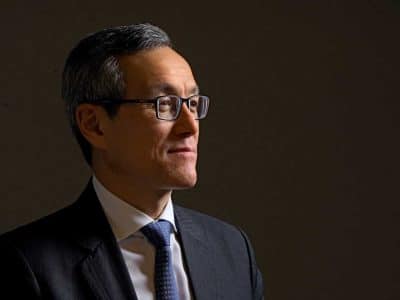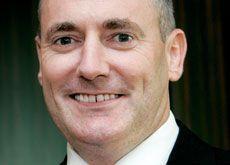An introduction to ten people who are helping to shape the future of the Middle East’s broadcasting industry.
They come from different parts of the broadcasting value chain. Some are running pay TV operations; others manage free to air and encrypted channels; others run state or quasi-state broadcasters and some have a mandate to develop local production talent and invest in Arabic content creation. What they all share in common is a commitment to seeing the industry move forward in the region. So here, in alphabetical order, are ten people whom we believe are helping to shape the future of the Middle East’s broadcasting industry.
Sam Barnett
MBC
Sam Barnett’s association with MBC began in 2002 when he worked as a consultant on the launch of what would become the Al Arabiya news & current affairs channel. Today, he is the COO and general manager of the MBC Group.
During his time there, MBC has developed into one of the most diverse private broadcasters in the Middle East, with movie, drama, entertainment and news channels. With the addition of MBC Persia, it now broadcasts in Arabic, English and Farsi.
In an interview with Digital Broadcast magazine, a sister publication, last year, Barnett claimed that 106 million people were watching MBC channels every day, a fact that has helped it at a time when advertisers are directing their investments towards only the most successful channels. “We are an efficient machine. We’re commercial, we’re profitable, we’re cashflow positive and we get the ratings,” he says.
Barnett has also been vocal in calling for greater audience measurement to boost the confidence of advertisers and direct money towards the most popular channels.
Ed Borgerding
Abu Dhabi Media Company and Imagenation
Ed Borgerding joined Abu Dhabi Media Company (ADMC) in 2008, also taking a senior role at Imagenation, Abu Dhabi’s film financing company. After a long career with Disney International, Borgerding was able to use his contacts to forge partnerships with blue chips such as National Geographic, Hyde Park Entertainment and Participant Media. A number of Abu Dhabi-funded international feature films are now in the works.
Development of Arabic language content and local filmmaking is one of Borgerding’s key objectives as head of ADMC. Around US $100 million was invested in the creation of the Arabic language National Geographic Channel Abu Dhabi. In April 2010, the company launched Abu Dhabi Drama, a 24×7 free-to-air drama channel, without any advertising breaks, focused on Khaliji, Egyptian and Syrian drama. Abu Dhabi Emarat, a channel focused on the heritage, culture and traditions of the UAE, was relaunched in October 2009 in a bid to increase its appeal.
The company will produce six Emirati films over the next two years and has created an internship programme offering young Emiratis placements in North America and India. The next big thing for ADMC is making the Premier League broadcast rights pay off. ADMC shelled out a reported US $300 million for the rights to show the Premier League for three years.
Marc-Antoine d’Halluin
OSN
These are busy times for Marc-Antoine d’Halluin, the CEO of OSN, the pay TV operator formed by last year’s merger of Orbit and Showtime. If last year was occupied by the merger, this year has been dominated by how to regroup following the loss of the English Premier League broadcast rights, a major driver of subscriptions.
The Frenchman’s response to the loss of OSN’s crown jewel has been to continue putting together agreements with major Hollywood studios and US networks. Couple that with a commitment to adopting the very latest technologies. The operator is currently rolling out HD set-top boxes to all its customers and now offers ten HD channels. D’Halluin has spoken of converting all Showtime’s 70+ channels to HD by the end of 2012 and switching off its SD services six months later. While all that is going on, OSN is looking into 3D and plans to offer 3D movies on-demand in the near future. This is all possible thanks to the rollout of those new boxes.
Sheikh Saleh Kamel
ART
With Arab Radio and Television Network’s (ART’s) recent sale of its sports broadcasting rights to Al Jazeera, it may look as if its star is waning. But Sheikh Saleh Abdullah Kamel’s ART still maintains something very valuable – the largest pay TV subscriber base in the region, at least according to an Informa report published last year.
Informa concluded then that ART had 894,000 subscribers compared to OSN’s 619,000. The researcher predicts that ART will have more than one million subscribers by 2011. The reason for ART’s lead is its focus on Arabic programming. It produces many popular Arabic language dramas and claims to own the largest library of Arabic language films. Plus, despite the sale of its international sports broadcasting rights to Al Jazeera, it retains the rights to broadcast the popular Saudi domestic league.
Wadah Khanfar
Al Jazeera
Its Arabic news channel made its reputation and the launch of the English language Al Jazeera International raised its profile further. Already one of the world’s most recognisable media brands, Wadah Khanfar has been quietly overseeing Al Jazeera’s expansion into new content areas beyond its original niche of news and current affairs. Al Jazeera Children’s Channel (JCC) and Al Baream are a growing hit with younger viewers. JCC recently upgraded its infrastructure to support tapeless workflow and multi-platform distribution.
Khanfar has moved the broadcaster into the realm of pay TV with the purchase of sports broadcasting rights such as the football World Cup and Champions League from ART. Although both events are certainly high profile, the reported US $1 billion paid to ART was a hefty chunk of money. Al Jazeera’s World Cup coverage also got off to a bad start this year, with the highly publicised loss of signals in the first few days and widespread confusion amongst consumers about how to subscribe to the channels. Still, with news, current affairs, a children’s channel and major sports events, Al Jazeera is rounding out its content portfolio. How long before it launches its own movie channel?
Dr Riyadh Najm
KSA Ministry of Culture
Dr Riyadh Najm is a stalwart of the Saudi Arabian television industry, having started his career as an engineer at Saudi TV in the 1980s. His current assignment as assistant deputy minister for engineering at the Ministry of Culture & Information brings with it a lot of responsibility. He is overseeing a massive investment in new broadcast technology at Saudi TV.
Moving all of Saudi TV’s new output to HD is one part of the plan, as is an extensive content restoration project. Further plans include the rollout of digital terrestrial television across the country, the establishment of radio and TV production facilities in each of the country’s provinces, and the kitting out of new portable HD studios and DSNG/OB vans.
Dr Najm is also president of the Arab States Broadcasting Union (ASBU) and chairperson of the HDTV Arab Group. Saudi TV has opted for 720p with a migration path to 1080p. Through the HDTV Arab Group, this is the approach he encourages all regional broadcasters to take.
Tony Orsten
twofour54
Industry veteran Tony Orsten, CEO of Abu Dhabi’s twofour54 media zone, has no small challenge on his hands: Turn Abu Dhabi into a media production hub and help drive forward Arabic language content creation. While it may take some time for Arabic language content creation to really take off, twofour54 has already made important moves. Its media production precinct is filling up with major names, such as CNN, Fox and Cartoon Network, and a brand new 600,000m² bespoke media zone is under construction at Mena Zayed. It will eventually house all of twofour54’s facilities and partner companies.
Last year’s launch of twofour54 intaj added another vital component to the overall twofour54 offering: a set of the state of the art HD production facilities, offering five studios ranging from 60 m² to 650m² in size. The studios are equipped to support production in a range of fields and are available for any third party to hire.
The opening complements twofour54 tadreeb, a vocational training academy, and twofour54 ibtikar, which provides industry funding and support. In calendar 2009, twofour54 tadreeb put over 800 media professionals through 55 courses. A specialised 12-month production skills programme for Emiratis kicks off in October.
Humaid Rashid Sahoo
e-Vision
Despite being limited to the UAE and facing the challenge of satellite pay TV operators, Etisalat’s cable service e-Vision has established itself as a successful arm of the UAE state telecomms operator. According to market research firm, Informa, the provider had 340,000 subscribers at this time last year. This makes it the UAE’s number one pay TV service, the largest offered by any Middle East telco and the third most-subscribed pay TV service in the region.
The operator launched HD TV services last year and now offers a broad swathe of sports, movie, nature, documentary, music and travel content in high definition. Recently, its parent company beging offering triple play services over fibre, which provide IP TV services, broadband internet and a landline as one single bundle. E-Vision entered the world of stereoscopic 3D when it struck a deal with Al Jazeera to broadcast its 2010 World Cup channels, which included a 3D offering.
Mohammed Al Shahi
Du Broadcast Services
Du Broadcast Services occupies an unusual position in the UAE television landscape. Its status as the exclusive provide to freehold developments in Dubai has given it a TV subscriber base of around 85,000 accounts. Yet it currently remains unable to offer its services outside of those developments.
According to the UAE telecomms regulator, that situation will soon change, allowing it to go after new customers, but also opening it up to competition on its own turf. To prepare for this new reality, Mohammed Al Shabhi, Du’s director of broadcast services, has overseen the transition of its cable service to an IP TV offering, dubbed ‘Du TV+’. New HD boxes have been rolled out to Du customers for free and as a result, the operator has been offering video on demand since December 2009.
The new offering is built on Microsoft’s Mediaroom IPTV software platform, which offers features such as digital video recording, video on demand, HDTV and multi-view capabilities. On June 1, Du launched a 3D channel, offering it for free under its basic TV package. The operator says it is in talks with various providers to bring more 3D content to its customers.
Hosam el Sokkari
Yahoo Maktoob
He is best known for his long stint in charge of BBC Arabic, but now, Hosam El Sokkari has entered the dot-com world as head of audience of Yahoo Maktoob, the company formed by Yahoo’s acquisition of the popular Maktoob portal last year. While the move may appear to represent a change of direction, a recent agreement with Rotana Middle East gives some idea as to where El Sokkari’s efforts may be focused.
The agreement will see www.maktoob.com‘s forthcoming Video Network channel populated with Rotana content. The deal combines Rotana’s position as the Arab world’s largest entertainment company, with maktoob.com’s popularity as an online destination. Rotana’s assets include Rotana Records, a film production company, television channels and radio stations. The move appears to make sense. Recently-released research claims that those with internet access in the region spend more time online than they do watching TV.
That opens up the possibility of Yahoo competing with conventional TV stations for TV advertising dollars. Future plans for the Rotana deal include mobile content and an IPTV offering. A content agreement is also rumoured to be in place with Lebanese broadcaster LBC and talks are underway with other potential content providers.






